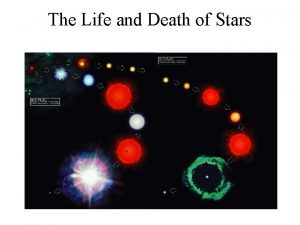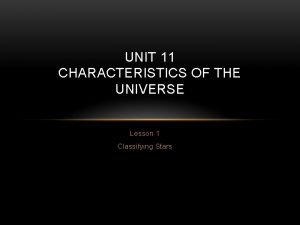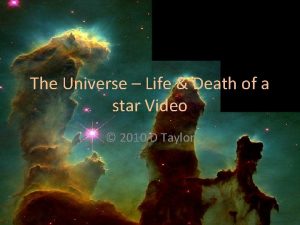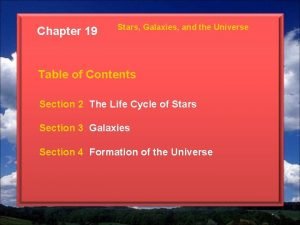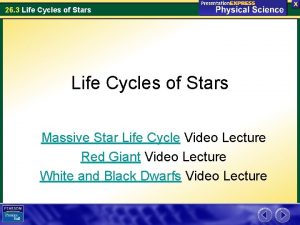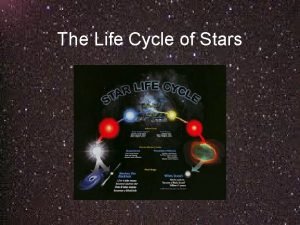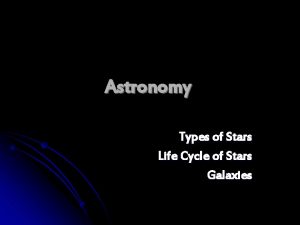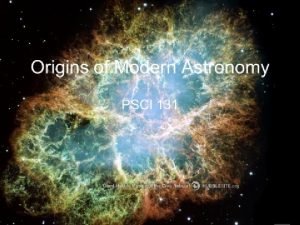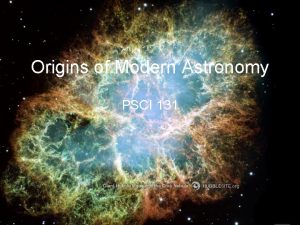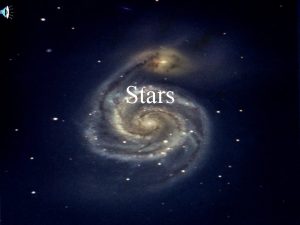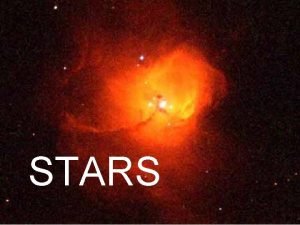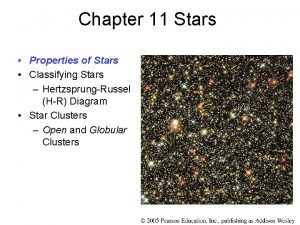PSCI 1414 GENERAL ASTRONOMY THE LIFE OF STARS


































- Slides: 34

PSCI 1414 GENERAL ASTRONOMY THE LIFE OF STARS PART 2: STAR CLUSTERS AND CLOSE BINARIES ALEXANDER C. SPAHN

POST–MAIN-SEQUENCE EVOLUTION To see how stars evolve during and after their main-sequence lifetimes, it is helpful to follow them on a Hertzsprung-Russell (H-R) diagram. On such a diagram, zero-age main-sequence stars lie along a line called the zero-age main sequence, or ZAMS. These stars have just emerged from their protostar stage, are steadily fusing hydrogen into helium in their cores, and have attained hydrostatic equilibrium.

POST–MAIN-SEQUENCE EVOLUTION With the passage of time, hydrogen in a mainsequence star’s core is converted to helium, the luminosity slowly increases, the star slowly expands. Therefore, the star’s position on the H-R diagram inches away from the ZAMS. As a result, the main sequence on an H-R diagram is a fairly broad band rather than a narrow line.

POST–MAIN-SEQUENCE EVOLUTION Stars whose cores have been exhausted of hydrogen and in which core hydrogen fusion has ceased have reached the ends of their main-sequence lifetimes. From there, the points representing high-mass stars (3 M⊙, 5 M⊙, and 9 M⊙) move rapidly from left to right across the H-R diagram.

POST–MAIN-SEQUENCE EVOLUTION Just before core helium fusion begins, the evolutionary tracks of high-mass stars turn upward in the red-giant region of the H-R diagram. After core helium fusion begins, however, the cores of these stars expand, the outer layers contract, and the evolutionary tracks back away from these temporary peak luminosities. The tracks then wander back and forth in the redgiant region while the stars readjust to their new energy sources.

POST–MAIN-SEQUENCE EVOLUTION The onset of core helium fusion in the low mass stars occurs with a helium flash. After the helium flash, these stars shrink and become less luminous. The decrease in size is proportionately greater than the decrease in luminosity, and so the surface temperatures increase. Hence, after the helium flash, the evolutionary tracks move down and to the left.

TRACKING 4½ BILLION YEARS OF STELLAR EVOLUTION We can summarize our understanding of stellar evolution from birth through the onset of helium fusion by following the evolution of a hypothetical cluster of stars. The stars that make up a cluster all begin to form at essentially the same time but have different initial masses. Hence, studying star clusters allows us to compare how stars of different masses evolve. The eight H-R diagrams in the following figures are from a computer simulation of the evolution of 100 stars that all form at the same moment and differ only in initial mass.

TRACKING 4½ BILLION YEARS OF STELLAR EVOLUTION All 100 stars begin as cool protostars on the right side of the H-R diagram. The protostars are spread out on the diagram according to their masses, and the greater the mass, the greater the protostar’s initial luminosity. Recall that the source of a protostar’s luminosity is its gravitational energy.

TRACKING 4½ BILLION YEARS OF STELLAR EVOLUTION The most massive protostars contract and heat up very rapidly. After only 5000 years, they have already moved across the H-R diagram toward the main sequence.

TRACKING 4½ BILLION YEARS OF STELLAR EVOLUTION After 100, 000 years, these massive stars have ignited hydrogen fusion in their cores and have settled down on the main sequence as O stars.

TRACKING 4½ BILLION YEARS OF STELLAR EVOLUTION After 3 million years, stars of moderate mass have also ignited core hydrogen fusion and become main-sequence stars of spectral classes B and A. Meanwhile, low-mass protostars continue to inch their way toward the main sequence as they leisurely contract and heat up.

TRACKING 4½ BILLION YEARS OF STELLAR EVOLUTION After 30 million years, the most massive stars have depleted the hydrogen in their cores and become red giants. These stars have moved from the upper left end of the main sequence to the upper right corner of the H-R diagram. Intermediate-mass stars lie on the main sequence, while the lowest-mass stars are still in the protostar stage and lie above the main sequence.

TRACKING 4½ BILLION YEARS OF STELLAR EVOLUTION After 66 million years, even the lowest-mass protostars have finally ignited core hydrogen fusion and have settled down on the main sequence as cool, dim, M stars. These lowest-mass stars can continue to fuse hydrogen in their cores for hundreds of billions of years.

TRACKING 4½ BILLION YEARS OF STELLAR EVOLUTION In the final two H-R diagrams, the main sequence stars get “peeled” or “eaten away” from the upper left to the lower right as stars exhaust their core supplies of hydrogen and evolve into red giants. The stars that leave the main sequence that have masses between about 1 M⊙ and 3 M⊙ undergo the helium flash in their cores.

CLUSTER AGES AND TURNOFF POINTS We can observe the early stages of stellar evolution in open clusters, which typically contain a few hundred to a few thousand stars. Many open clusters are just a few million years old, so their H-R diagrams resemble stages e, d, or f in the previous figures. Star clusters tend to form in a very short period of time compared to how long their stars shine, which means each cluster has an age—the time since its formation.

CLUSTER AGES AND TURNOFF POINTS This figure shows two open clusters of different ages. The nearer cluster, called M 35, must be relatively young because it contains several dozen luminous, blue, high-mass main-sequence stars. These stars lie in the upper part of the main sequence on an H-R diagram. They have main-sequence lifetimes of only a few hundred million years, so M 35 can be no older than that. The H-R diagram for this cluster resembles Figure 19 -10 g.

CLUSTER AGES AND TURNOFF POINTS There are no high-mass blue main-sequence stars at all in NGC 2158, the further cluster in the figure. Any such stars that were once in NGC 2158 have long since come to the end of their main-sequence lifetimes. As a result, the main sequence in this cluster has been “eaten away” more than that of M 35, leaving only stars that are yellow or red in color. This tells us that NGC 2158 must be older than M 35. This example shows that as a cluster ages, it generally becomes redder in its average color.

CLUSTER AGES AND TURNOFF POINTS We can see even later stages in stellar evolution by studying globular clusters, so called because of their spherical shape. A typical globular cluster contains up to 1 million stars in a volume less than 100 pc across. Among these are many highly evolved post–main-sequence stars.

MEASURING THE AGES OF STAR CLUSTERS The idea that a cluster’s main sequence is progressively “eaten away” is the key to determining the age of a cluster. In the H-R diagram for a very young cluster, all the stars are on or near the main sequence. As a cluster gets older, however, stars begin to leave the main sequence. The high-mass, high-luminosity stars are the first to consume their core hydrogen and become red giants. As time passes, fewer and fewer stars remain on the main sequence.

MEASURING THE AGES OF STAR CLUSTERS The age of a cluster can be found from the turnoff point, which is at the peak of the surviving portion of the mainsequence stars on the cluster’s H-R diagram. The stars at the turnoff point are just at the stage of exhausting the hydrogen in their cores, so their mainsequence lifetime is equal to the age of the cluster. Since we know the main-sequence lifetimes of stars with differing masses through modeling, we are able to determine how long ago the cluster formed.

MEASURING THE AGES OF STAR CLUSTERS This figure shows data for several star clusters plotted on a single H-R diagram. This graph also shows turnoff-point times from which the ages of the clusters can be estimated. Notice that the lower down the turnoff point occurs (which corresponds to lower masses moving off the main sequence), the older the cluster.

MEASURING THE AGES OF STAR CLUSTERS Using the figure, explain why turnoff points at lower luminosities correspond to older clusters. Recall that lower-mass stars are less luminous. Therefore, the lower the luminosity of the turnoff point, the lower the mass of the main-sequence star at the turnoff point. Lower-mass stars remain on the main sequence longer, indicating an older cluster when these stars finally leave the main sequence.

CLOSE BINARY SYSTEMS We have outlined what happens when a main-sequence star evolves into a red giant. What we have ignored is that more than half of all stars are members of multiple-star systems. If the stars in such a system are widely separated, the individual stars follow the same course of evolution as if they were isolated. In a close binary, however, when one star expands to become a red giant, its outer layers can be gravitationally captured by the nearby companion star. In other words, a bloated red giant in a close binary system can dump gas onto its companion, a process called mass transfer.

ROCHE LOBES AND LAGRANGIAN POINTS Tidal forces cause the two stars in a close binary to keep the same sides facing each other, just as our Moon keeps its same side facing Earth. But because stars are gaseous, not solid, rotation and tidal forces can have significant effects on their shapes. In close binaries, where the separation between the stars is not much greater than their sizes, tidal effects are strong, causing the stars to be somewhat egg or teardrop-shaped.

ROCHE LOBES AND LAGRANGIAN POINTS There exists a mathematical surface that marks the gravitational domain of each star in a close binary. This figure shows the outline of this surface as a dashed line. The two halves of this surface, each of which encloses one of the stars, are known as Roche lobes. The more massive star is always located inside the larger Roche lobe. If gas from a star leaks over its Roche lobe, it is no longer bound by gravity to that star. This escaped gas is free either to fall onto the companion star or to escape from the binary system.

ROCHE LOBES AND LAGRANGIAN POINTS If gas from a star leaks over its Roche lobe, it is no longer bound by gravity to that star. This escaped gas is free either to fall onto the companion star or to escape from the binary system. The point where the two Roche lobes touch, called the inner Lagrangian point, is a kind of balance point between the two stars in a binary. It is here that the effects of gravity and rotation cancel each other. When mass transfer occurs in a close binary, gases flow through the inner Lagrangian point from one star to the other.

ROCHE LOBES AND LAGRANGIAN POINTS In many binaries, the stars are so far apart that even during their red-giant stages the surfaces of the stars remain well inside their Roche lobes. As a result, little mass transfer can occur and each star lives out its life as if it were single and isolated. A binary system of this kind is called a detached binary.

ROCHE LOBES AND LAGRANGIAN POINTS However, if the two stars are close enough, when one star expands to become a red giant, it may fill or overflow its Roche lobe. Such a system is called a semidetached binary.

ROCHE LOBES AND LAGRANGIAN POINTS If both stars fill their Roche lobes, the two stars actually touch and the system is called a contact binary. It is quite unlikely, however, that both stars exactly fill their Roche lobes at the same time.

ROCHE LOBES AND LAGRANGIAN POINTS It is more likely that they overflow their Roche lobes, giving rise to a common envelope of gas. Such a system is called an overcontact binary.

OBSERVATIONS OF MASS TRANSFER The binary star system Algol provided the first clear evidence of mass transfer in close binaries. Ancient astronomers knew that Algol varies periodically in brightness by a factor of more than 2. In 1782, John Goodricke first suggested that these brightness variations take place because Algol is an eclipsing binary. The orbital plane of the two stars that make up the binary system happens to be nearly edge-on to our line of sight, so one star periodically eclipses the other.

OBSERVATIONS OF MASS TRANSFER Mass transfer is also important in another class of semidetached binaries, called β (beta) Lyrae variables. As with Algol, the less massive star in β Lyrae fills its Roche lobe. Unlike Algol, however, the more massive detached star is the dimmer of the two stars. This detached star is enveloped in a rotating accretion disk of gas captured from its bloated companion. This disk partially blocks the light coming from the detached star, making it appear dimmer.

OBSERVATIONS OF MASS TRANSFER Mass transfer can also continue even after nuclear reactions cease in one of the stars in a close binary. In Chapters 20 and 21 we will see how mass transfer onto different types of dead stars called white dwarfs, neutron stars, and black holes can produce some of the most unusual and dramatic objects in the sky.

FOR NEXT TIME… • Read first half of Chapter 20 • Homework 23: Chapter 19 questions 15, 16, 25, 27 (Due Monday, April 25)
 Jeremias 1414 falsos profetas
Jeremias 1414 falsos profetas Learning astronomy by doing astronomy activity 1 answers
Learning astronomy by doing astronomy activity 1 answers Learning astronomy by doing astronomy answers
Learning astronomy by doing astronomy answers Learning astronomy by doing astronomy
Learning astronomy by doing astronomy Schnauzer dogs there are three sizes
Schnauzer dogs there are three sizes Psci audit
Psci audit Pharmaceutical supply chain initiative psci
Pharmaceutical supply chain initiative psci Pharmaceutical supply chain initiative
Pharmaceutical supply chain initiative Red supergiant life cycle
Red supergiant life cycle Life cycle of a star notes
Life cycle of a star notes The life and death of stars
The life and death of stars Star life cycle simulation
Star life cycle simulation Life cycle of stars graphic organizer
Life cycle of stars graphic organizer Life and death of a star video
Life and death of a star video Chapter 19 section 2 the life cycle of stars answer key
Chapter 19 section 2 the life cycle of stars answer key Life cycle of a star assessment
Life cycle of a star assessment Life cycles of stars
Life cycles of stars Flowchart of the life cycle of a star
Flowchart of the life cycle of a star Hình ảnh bộ gõ cơ thể búng tay
Hình ảnh bộ gõ cơ thể búng tay Ng-html
Ng-html Bổ thể
Bổ thể Tỉ lệ cơ thể trẻ em
Tỉ lệ cơ thể trẻ em Gấu đi như thế nào
Gấu đi như thế nào Tư thế worm breton là gì
Tư thế worm breton là gì Alleluia hat len nguoi oi
Alleluia hat len nguoi oi Các môn thể thao bắt đầu bằng tiếng đua
Các môn thể thao bắt đầu bằng tiếng đua Thế nào là hệ số cao nhất
Thế nào là hệ số cao nhất Các châu lục và đại dương trên thế giới
Các châu lục và đại dương trên thế giới Công của trọng lực
Công của trọng lực Trời xanh đây là của chúng ta thể thơ
Trời xanh đây là của chúng ta thể thơ Cách giải mật thư tọa độ
Cách giải mật thư tọa độ Làm thế nào để 102-1=99
Làm thế nào để 102-1=99 độ dài liên kết
độ dài liên kết Các châu lục và đại dương trên thế giới
Các châu lục và đại dương trên thế giới Thơ thất ngôn tứ tuyệt đường luật
Thơ thất ngôn tứ tuyệt đường luật










